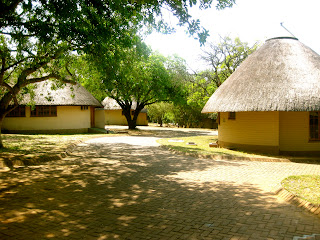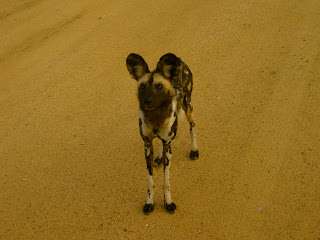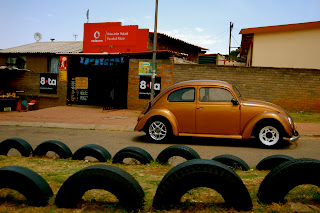Sunday at around 6:43am, I was met by Kylie, a sweet south african employee of the tour company most likely in her mid- to later twenties. She then picked up two older british couples and we headed to Kruger game reserve, arriving several hours later. We were greeted by two lions right away on our way into the reserve towards the Skukuza camp. Our accommodations could be compared to smurf village, with small circular huts with standard bathroom and kitchen units. We headed out on our first game drive that evening and stumbled onto impala (which are everywhere), elephants, buffalo, baboons, other monkeys, a giraffe, etc.
A true african sunset...edited of course
The tour was with a limited number of guests, so the ability to document and photograph the sightings were much easier since jockeying for space wasn't a big deal. Our guide Willem is like a south african Richard Branson, with a thicker accent, more slender body, and much longer hair, like Jesus's.
The drive lasted for about 4 hours and we headed back to our huts, and were picked up again an hour later for a dinner that was prepared by the crew. The package I purchased included all transportation to and from Kruger, all meals, 4 game drives, and accommodation.
Go time the next morning was at 4am. We had breakfast, then headed out and saw more wildlife, the first of which were a group of these wild dogs:
My sunset drive was several hours later which ended up with us seeing a large white rhino and her baby, which almost charged towards our vehicle. The last game drive the next morning boasted only a few animal sightings but our journey back home down the 'panoramic route' was worth the extra hours it took to get back. The Jacaranda trees were breathtaking.
That night, we headed down the street to Montecasino. This casino is quite similar to the Venetian in Vegas which boasts a guantlet of shops and the ceiling is painted like the sky. The theater shown below hosts concerts of all music genres. The complex even has a bellagio-like fountain on a much smaller scale.
The recent past of South Africa is something I wanted to learn more about, so a visit to the Apartheid museum was in order. The entrance to the facility was marked with separate "white" and "non-white" doorways. There was a wealth of information to read about. Gold was discovered in Joburg in 1886 and over the next few years, Joburg produced 27% of the world's gold. This discovery brought people of all races to the area for mining operations and a short while afterwards, townships began to spring up due to the drastically increasing population growth. These townships became synonymous with disease and crime and the largely white government attributed these misfortunes to the colored population. They then established panels to identify all residents of South Africa by color (white, native, black, etc.). This was a highly subjective process, and thus controversial. This started the movement toward a society crippled with apartheid.
The museum was ripe with documents, stories, anecdotes and dealings with Nelson Mandela. His struggle is truly quite remarkable and the only way to grasp the gravity of his contributions is to visit the museum. Pro-white political parties, almost representing Nazi ideals embraced the ideals of apartheid, a plethora of laws were enacted to prevent non-whites from excelling, and peaceful movements started becoming violent with a few known massacres (Sharpeville). What I learned a few days later in Soweto turned the tide against the oppression against the non-whites.
Later that afternoon, we headed to Sandton, an upscale community with massive amounts of restaurants and stores. The new addition to the mall is shown below.
The next day, Tegan, Lauren and myself headed to Sun City, about two hours away from Jozi. We spent several hours at the water park (wave pool, slides, regular pool, etc.) and enjoyed food service to our sand dwelling.
The ride back brought us through Hartbeespoort Dam, which has beautiful sunsets I'm told (however, it was cloudy that evening and a lightning storm was imminent).
Since I couldn't bungee jump in Bloukrans (the longest bungee in the world, 216 meters), Tegan suggested I do the Orlando Towers in Soweto...so that's what I did. For about $60, I got a chance to go up one tower of a decommissioned coal fire power plant and jump 100 meters. We scheduled the jump for the early morning and found four others getting strapped up as well, all of which were doing the bungee swing (amateurs). I paid the coin, signed my life away, and ascended the tower with the proper apparatus on my person. I suppose the trick is to never look down, but I'm human, so of course I do. I pass those for the swing and make my way to the bungee platform, suspended in the middle of the towers. The bridge towards it reminded me of the derelict bridges found in the indigenous populations portrayed in any Indiana Jones movie, though this was a bit more secure.
Man: "Ah the man from DC, you look like you gonna shit yo pants man!"
Me: "...I wish I didn't wear white."
They buckle me into the setup, go through the checks, and without hesitation, move me to the end of the platform and tell me not to look down and proceed to countdown from 5. Without any second guessing I jumped and the rest is history. It felt quite amazing to be on land again.
After the jump, we went through a tour of Soweto, the largest township in south africa, and home to 5 million residents. TK, a local gave us the very insightful tour and brought us through every corner of town. The most interesting part was when we stopped by the Hector Pieterson museum. This was probably the most emotionally I've felt since I've been here. As I mentioned above, as the non-whites began to peacefully protest against the apartheid regime, violence occurred in greater frequency. In Soweto, the government instituted that all schools teach in Afrikaans language instead of english. This was seen as a malicious intent by the government to further isolate the black population from any economic prosperity since most did not know afrikaans. This created tension in the area and gave rise to the Soweto uprising. Fifteen thousands students protested on June 16, 1976 and after some commotion, shots were fired by the police which led to the deaths of 600 schoolkids and thousands more were wounded. One of the kids was Hector Pieterson, a 12 year old, who can be directly compared to Rosa Parks in terms of how he inspired the movement. He passed away later that day. Afterwards, we went through more of the township.
On our way back home, we stopped by Soccer City, one of the main venues for the World Cup.
Today we headed to SAB, South African Breweries for a tour and lunch. As with any brewery, it ruled.
I am leaving in 20 minutes to head to the airport and will be back home in a little over a day.
Afrikaans lesson #13
vaai - "let's go"
This experienced has taught me much about the world and about myself. I didn't go into it thinking it would be cathartic or life changing, but I can say with confidence that it was. I didn't get mugged though I never put myself in the situation to. Everyone I met was extremely friendly. Everyone I met was a proud South African. Everyone I met made a profound impact on my life. Their hospitality is inspiring, the culture is eclectic, their women are beautiful and I will be back at some point in my life.
CK




































